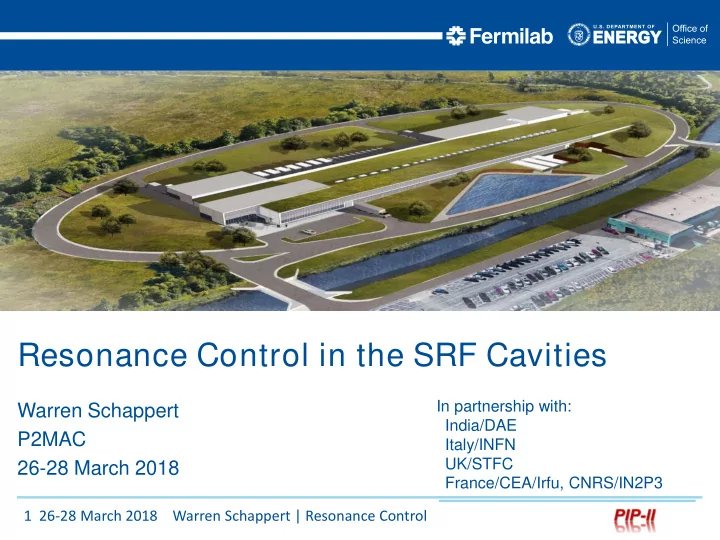

Resonance Control in the SRF Cavities In partnership with: Warren Schappert India/DAE P2MAC Italy/INFN UK/STFC 26-28 March 2018 France/CEA/Irfu, CNRS/IN2P3 1 26-28 March 2018 Warren Schappert | Resonance Control
Cavity Microphonics • SRF cavities manufactured from thin sheets of niobium and operate with narrow bandwidths • Mechanical distortion of the cavities can change the resonant frequency requiring more RF power to maintain the gradient • Providing sufficient margin increases capital and operating costs 2 26-28 March 2018 Warren Schappert | Resonance Control
Mitigating Microphonics • Suppressing cavity detuning requires multi- pronged approach including (but not limited to) – Cavity/Cryomodule Design – Tuner Performance and Reliability – Passive Suppression – Active Compensation • PIP-II has very aggressive resonance control specifications 3 26-28 March 2018 Warren Schappert | Resonance Control
Cavity/Cryomodule Design • SSR1 Cavity and tuner design were completed some time ago – Considerable effort has gone into minimizing df/dP for the SSR1 cavities – Low df/dP may reduce sensitivity to TAOs • Design of 650 Cavity/Tuner system is currently underway – Effort to minimize LFD • SSR1 cryomodule design is incorporating lessons learned from LCLS-II – Thermally strapping instrumentation lines to reduce TAOs 4 26-28 March 2018 Warren Schappert | Resonance Control
Tuner Performance and Reliability • LCLS-II tuner developed in close collaboration with experienced vendors with strong emphasis on reliability – PI Encapsulated piezo stacks – Phytron cryogenic stepper motors • Tuner component reliability testing program is ongoing – Radiation hardness – Piezo heating during pulsed operation • Cold testing of complete cavity/tuner assemblies is critical 5 26-28 March 2018 Warren Schappert | Resonance Control
Passive Suppression • LCLS-II production testing provides important lessons for PIP-II • Initial microphonics levels were Detuning Frequency [Hz] much higher than expected – Thermo-acoustic oscillations (TAOs) identified as primary source of detuning • Over the course of a year cross-disciplinary effort was able to bring levels down to specification • Effort required multiple cryomodule design modifications to during “production” testing 6 26-28 March 2018 Warren Schappert | Resonance Control
PIP-II Cavity Test Stand Environment • Considerable effort has gone into eliminating TAOs and other noise sources in the LCLS-II cryogenic system • No comprehensive effort yet to identify and mitigate noise sources in STC – Noise background and valve icing in adjacent HTS would indicate that TAOs are likely present • Improving the cryogenic system will require time and resources but must be undertaken if test stand resonance control tests are to be taken seriously • Similar efforts will be required for cryomodule and string test 7 26-28 March 2018 Warren Schappert | Resonance Control
STC Testing • Demonstration in the previous year using showed that it was possible to stabilize the SSR1 resonance in pulsed mode to within a factor of 2 (or better) of the specification. – Specification may well have been met but it is unclear because of uncertainties in cavity gradient (possible coupler damage) • Problems with SSR1 production prevented repeating the demonstration this year – SSR1 production problems apparently now resolved • Hope to repeat demonstration during next upcoming SSR1 test 8 26-28 March 2018 Warren Schappert | Resonance Control
LCLS-II Active Compensation Tests • TD/Resonance Control group working in collaboration with LCLS-II/LLRF group to implement FNAL developed algorithms on LCLS-II hardware • LCLS-II tests have given a much better understanding of what will be required for active compensation – Now possible to measure cavity transfer function and noise spectrum, automatically generate a compensation filter, and predict the feedback suppression factor • LCLS-II active compensation tests are ongoing 9 26-28 March 2018 Warren Schappert | Resonance Control
Pulsed vs CW Operation • Good results with active control for both pulsed and CW operation • Range of possibilities between original PIP-II pulsed mode specifications and pure CW operation – Some low power CW drive always envisioned to provide continuous sensitivity to detuning – Mechanical excitation depends on RF pulse risetime 10 26-28 March 2018 Warren Schappert | Resonance Control
Feedforward Compensation • Current LCLS-II noise spectra show a large (~50%) component just below 30 Hz that slowly oscillates – Interference between two large induction motors operating • One source had been identified as Kinney pump • Other needs to be identified – Passive suppression may be limited • DESY has had success using feedforward to compensate for external vibration sources – Need to incorporate this capability into PIP-II resonance control hardware 11 26-28 March 2018 Warren Schappert | Resonance Control
Conclusion • Resonance stabilization is recognized as a critical consideration in the design of PIP-II – Resonance control needs to be part of specifications and review for each component of the machine • PIP-II production testing has been delayed but is expected to resume shortly – Time for resonance control studies allocated during production tests • In the meantime LCLS-II testing has provided considerable insight to what will be required for both passive suppression and active control of the PIP-II cavities – Template for successful collaboration needed during upcoming PIP-II cryomodule tests – Passive suppression is critical – Active compensation alone will not be adequate – Lessons learned are being incorporated into PIP-II design • Need to adapt our strategy to take into account what we have learned 12 26-28 March 2018 Warren Schappert | Resonance Control
Recommend
More recommend